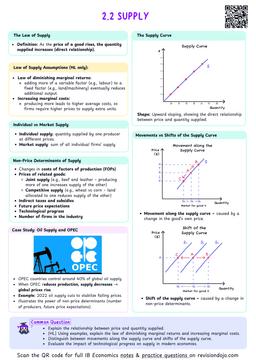Economic growth
An increase in a country's real output (real GDP) over a period time.
- Economic growth refers to an increase in a country's real gross domestic product (GDP) over time.
- The real output is the value of an economy's national output after it has been adjusted for inflation. It reflects the true value of goods and services produced in a given year.
- Economic growth is usually expressed as the country's annual percentage change in the value of the country's real national output.
There are two types of economic growth:
- Short-term economic growth: changes in actual output within the existing capacity of the economy.
- Long-term economic growth: expansion of the economy's productive capacity over time.
Short-term growth
- Short-term economic growth occurs when an economy moves from operating below its capacity to producing more within its current resources.
- This is represented as actual growth in the PPC model and by changes in aggregate demand (AD) in the AD/AS model.
Actual growth in the PPC model
Production possibilities curve (PPC)
Curve that illustrates all possible combinations of two goods that an economy can produce at maximum output when using all available resources and current technology efficiently.
- The Production Possibility Curve (PPC) represents an economy's maximum potential output given its available resources.
- Short-term growth happens when an economy moves closer to its PPC, meaning previously unused resources (unemployed labor or idle factories) are now being utilized.
- This is often caused by increases in demand, investment, or improved efficiency in production.

Figure 1 above illustrates actual growth in the PPC model of an economy producing manufacturing goods and agricultural goods:
- An increase in the use of available resources through (for example) efficiency gains, allows more of both goods to be produced.
- This moves the economy's production closer to its PPC from Point A to Point B, demonstrating actual growth.
A country with high unemployment experiences an increase in government spending, leading to higher production and employment, pushing the economy closer to its PPC.
Role of AD in the AD/AS Model
Aggregate demand
The total quantity of real output that all buyers in an economy (consumers, businesses, the government, and foreigners) are willing to purchase over a specific time period, at all possible price levels, ceteris paribus.
Aggregate Demand (AD) consists of:
$$AD=C+I+G+(X−M)$$
where:
- $C$ = Consumer spending.
- $I$ = Investment by businesses.
- $G$ = Government expenditure.
- $X−M$ = Net exports (Exports - Imports).
Remembering the components of aggregate demand is essential in IB Economics.
In the AD/AS model, short-term economic growth occurs when aggregate demand (AD) increases, leading to higher output and employment. This is showcased in Figure 2:

- When AD shifts ($AD_1$ → $AD_2$), firms respond by producing more goods and services.
- This establishes a new equilibrium ($Y_1$,$Pl_1$ → $Y_2$,$Pl_2$), leading to an increase in real output ($Y_1$ → $Y_2$) and economic growth.
- This economic growth happens without an increase in production possibilities (notice how LRAS stays constant).


